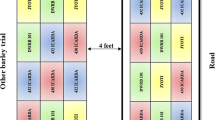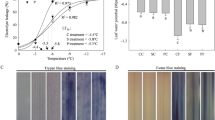Abstract
The present study was undertaken to study the effect of osmo priming on sucrose metabolism of spring maize, under limited irrigation conditions. Osmo priming increased the activities of acid invertase, alkaline invertase and sucrose synthase (cleavage) and the contents of reducing sugars and starch in the grains of stressed plants. There was also an increase in sucrose phosphate synthase activity with a parallel increase in sucrose content in leaves of stressed plants in comparison with those of hydro priming treatment. It showed that osmo priming helped in improving sucrose phosphate synthase activity in leaves of plants, leading to higher sucrose content, under stress conditions.




Similar content being viewed by others
References
Afzal I, Rauf S, Basraand SMA, Murtaza G (2008) Halopriming improves vigor, metabolism of reserves and ionic contents in wheat seedlings under salt stress. Plant Soil Environ 54(9):382–388
Chatterjee N, Sarkar D, Sankar A, Pal S, Singh HB, Singh RJ, Bohra JS, Rakshit A (2018) On-farm seed priming interventions in agronomic crops. Acta Agric Slov 111:716–735
Chaves MM, Oliveira MM (2004) Mechanisms underlying plant resilience to water deficits: prospects for water-saving agriculture. J Exp Bot 407:2365–2384
Dagdelen N, Yilmaz E, Sezgin F, Gurbuz T (2006) Water-yield relation and water use efficiency of cotton (Gossypium hirsutum L.) and second crop corn (Zea mays L.) in western Turkey. Agric Water Manage 82:63–85
de Carvalho MHC (2008) Drought stress and reactive oxygen species. Plant Signal Behav 3(3):156–165
Dey PM (1986) Changes in the forms of invertase during germination of mungbean. Phytochemistry 25:51–53
Dubois M, Gilles KA, Hamilton JK, Robers PA, Smith F (1956) Colorimetric method for determination of sugars and related substances. Anal Chem 28:350–356
Farooq M, Basra SMA, Hafeez K (2006) Rice seed invigoration by osmohardening. Seed Sci Technol 34:181–186
Farooq M, Wahid A, Ahmad N, Asad SA (2010) Comparative efficacy of surface drying and re-drying seed priming in rice: changes in emergence, seedling growth and associated metabolic events. Paddy Water Environ 8:15–22
Food and Agriculture Organization (2018) FAOSTAT. The food and agricultural organization of the united nations, Rome. http://www.faostat.fao.org/
Gechev TS, Breusegem FV, Stone JM, Denev I, Laloi C (2006) Reactive oxygen species as signals that modulate plant stress responses and programmed cell death. Bioessays 28:1091–1101
Gibson SI (2005) Control of plant development and gene expression by sugar signaling. Curr Opin Plant Biol 8:93–102
Gupta AK, Kaur K, Kaur N (2011) Stem reserve mobilization and sink activity in wheat under drought conditions. Am J Plant Sci 2:70–77
Hanegave AS, Hunje R, Nadaf HL, Biraderpatil NK, Uppar DS (2011) Effect of seed priming on seed quality of maize (Zea mays L.). Karnataka J Agric Sci 24:237–238
Hussain M, Bashir W, Farooq S, Rehim A (2013) Root development, allometry and productivity of maize hybrids under terminal drought sown by varying methods. Int J Agric Biol 15:1243–1250
Jeon JS, Ryoo N, Hahn TR, Walia Hand Nakamura Y (2010) Starch biosynthesis in cereal endosperm. Plant Physiol Biochem 48:383–392
Joudi M, Ahmadi A, Mohammadi V, Abbasi A, Mohammadi H (2014) Genetic changes in agronomic and phenologic traits of Iranian wheat cultivars grown in different environmental conditions. Euphytica 196:237–249
Kaur S, Gupta AK, Kaur N (2002) Effect of osmo and hydro priming of chickpea seeds on seedling growth and carbohydrate metabolism under water deficit stress. Plant Growth Regul 37:17–22
Kaur S, Gupta AK, Kaur N (2005) Seed priming increases crop yield possibly by modulating enzymes of sucrose metabolism in Chickpea. J Agron Crop Sci 191:81–87
Kaur K, Gupta AK, Kaur N (2007) Effect of water deficit on carbohydrate status and enzymes of carbohydrate metabolism in seedlings of wheat cultivars. Indian J Biochem Biophys 44:223–230
Kerr PS, Kalt-Torres W, Huber SC (1987) Resolution of two molecular forms of sucrose-phosphate synthase from maize, soyabean and spinach leaves. Planta 170:515–519
Kijne J, Barker R, Molden D (2003) Water productivity in agriculture: limits and opportunities for improvement, comprehensive assessment of water management in agriculture. CABI Publishing in Association with International Water Management Institute, London
Kim JY, Mahe A, Brangeon J, Prioul JL (2000) A maize vacuolar invertases, IVR2, is induced by water stress: organ/tissue specificity and diurnal modulation of expression. Plant Physiol 124:71–84
Krzysztof S, Gabriela L (2007) Changes in carbohydrate metabolism in fine roots of the native European black poplar (Populus nigra L.) in a heavy-metal-polluted environment. Sci Total Environ 373:157–165
Kuznetsov VV, Rakitin VY, Zholkevich VN (1999) Effects of preliminary heat-shock treatment on accumulation of osmolytes and drought resistance in cotton plants during water deficiency. Physiolplanta 107:399–406
Liang J, Zhang J, Cao X (2001) Grain sink strength may be related to the poor grain filling of indica—japonica rice (Oryza sativa L.) hybrids. Physiol Plant 112:470–477
Mahboob W, Rehman HU, Basra SMA, Afzal I, Abbas MA, Naeem M, Abbas M (2015) Seed priming improves the performance of late sown spring maize (Zea mays) through better crop stand and physiological attributes. Int J Agric Biol 17:491–498
Manaf HH, Ashour HM, El- Hamadi MM (2017) Impact of calcium chloride on resistance drought and blossom-end rot in sweet pepper plants (Capsicum annuum L.). Middle East J Appl Sci 7:335–348
Nayer M, Heidari R (2008) Drought-induced accumulation of soluble sugars and proline in two maize varieties. World Appl Sci J 3(3):448–453
Nayyar H, Walia DP (2004) Genotypic variation in wheat in response to water stress and abscisic acid-induced accumulation of osmolytes in developing grains. J Agron Crop Sci 190(1):39–45
Nelson N (1944) A photometric adaptation of the somogoyi method for the determination of glucose. J Biol Chem 153:375–380
Pelleschi S, Rocher JP, Prioul JL (2008) Effect of water restriction on carbohydrate metabolism and photosynthesis in mature maize leaves. Plant Cell Environ 20(4):493–503
Pennisi E (2008) The blue revolution, drop by drop, gene by gene science. Plant Genet 320:171–173
Pokhilko A, Ebenhoh O (2015) Mathematical modelling of diurnal regulation of carbohydrate allocation by osmo-related processes in plants. J R Soc Interface. https://doi.org/10.1098/rsif.2014.1357
Raun YL (2014) Sucrose metabolism: gateway to diverse carbon use and sugar signaling. Ann Rev Plant Biol 65:33–67
Roe JH (1934) A colorimetric method for the determination of fructose in blood and urine. J Biol Chem 107:15–22
Saeedipour S (2011) Comparison of the drought stress responses of tolerant and sensitive wheat cultivars during grain filling: impact of invertase activity on carbon metabolism during kernel development. J Agric Sci 3:32–44
Trouverie J, Thâevenot C, RocherJ P, Sotta B, Prioul JL (2003) The role of abscisic acid in the response of a specific vacuolar invertase to water stress in the adult maize leaf. J Exp Bot 54:2177–2186
USDA (2018) India grain and feed annual 2018. www.fas.usda.gov/database/global-agricultural-information-network-gain
Wingler A, Lea PJ, Quick WP, Leegood RC (2000) Photorespiration: metabolic pathways and their role in stress protection. Philos Trans R Soc Lond B 355:1517–1529
Yang J, Zhang J, Wang Z, Zhu Q, Liu L (2004) Activities of fructan- and sucrose-metabolizing enzymes in wheat stems subjected to water stress during grain filling. Planta 220:331–343
Author information
Authors and Affiliations
Corresponding author
Ethics declarations
Conflict of interest
The authors declare that they have no conflict of interest.
Additional information
Publisher's Note
Springer Nature remains neutral with regard to jurisdictional claims in published maps and institutional affiliations.
Rights and permissions
About this article
Cite this article
Kawatra, M., Kaur, K. & Kaur, G. Effect of osmo priming on sucrose metabolism in spring maize, during the period of grain filling, under limited irrigation conditions. Physiol Mol Biol Plants 25, 1367–1376 (2019). https://doi.org/10.1007/s12298-019-00706-z
Received:
Revised:
Accepted:
Published:
Issue Date:
DOI: https://doi.org/10.1007/s12298-019-00706-z




